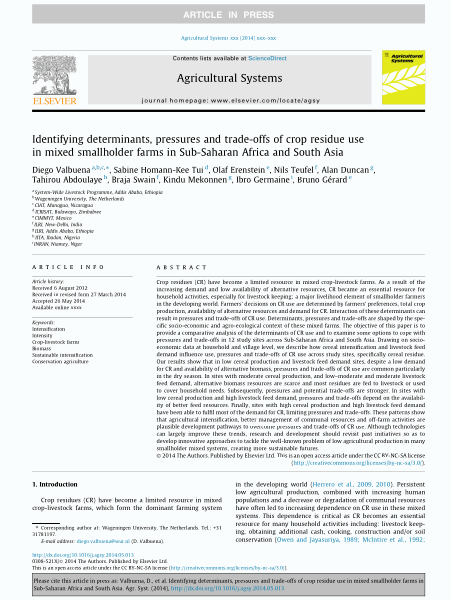Identifying determinants, pressures and trade-offs of crop residue use in mixed smallholder farms in Sub-Saharan Africa and South Asia
Crop residues (CR) have become a limited resource in mixed crop-livestock farms. As a result of the increasing demand and low availability of alternative resources, CR became an essential resource for household activities, especially for livestock keeping; a major livelihood element of smallholder farmers in the developing world. Farmers’ decisions on CR use are determined by farmers’ preferences, total crop production, availability of alternative resources and demand for CR. Interaction of these determinants can result in pressures and trade-offs of CR use. Determinants, pressures and trade-offs are shaped by the specific socio-economic and agro-ecological context of these mixed farms. The objective of this paper is to provide a comparative analysis of the determinants of CR use and to examine some options to cope with pressures and trade-offs in 12 study sites across Sub-Saharan Africa and South Asia. Drawing on socio-economic data at household and village level, we describe how cereal intensification and livestock feed demand influence use, pressures and trade-offs of CR use across study sites, specifically cereal residue. Our results show that in low cereal production and livestock feed demand sites, despite a low demand for CR and availability of alternative biomass, pressures and trade-offs of CR use are common particularly in the dry season. In sites with moderate cereal production, and low–moderate and moderate livestock feed demand, alternative biomass resources are scarce and most residues are fed to livestock or used to cover household needs. Subsequently, pressures and potential trade-offs are stronger. In sites with low cereal production and high livestock feed demand, pressures and trade-offs depend on the availability of better feed resources. Finally, sites with high cereal production and high livestock feed demand have been able to fulfil most of the demand for CR, limiting pressures and trade-offs. These patterns show that agricultural intensification, better management of communal resources and off-farm activities are plausible development pathways to overcome pressures and trade-offs of CR use. Although technologies can largely improve these trends, research and development should revisit past initiatives so as to develop innovative approaches to tackle the well-known problem of low agricultural production in many smallholder mixed systems, creating more sustainable futures.

